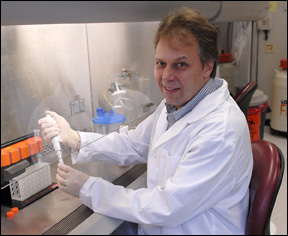State funds new stem cell imaging system to bolster disease prevention research

SYRACUSE, N.Y.— The creation of a centralized human Stem Cell Processing Laboratory at SUNY Upstate Medical University and the purchase of an imaging system that shows in actual time how stem cells develop into the human immune system will be realized through approximately $450,000 in funding from New York State and from SUNY Upstate.
The laboratory will be located in Weiskotten Hall on the SUNY Upstate campus. It will serve as a core facility to be shared by researchers at SUNY Upstate and other researchers across the nation who are involved in stem cell research. Findings from stem cell research could gain insight into disease prevention and could lead to new treatments, therapies and vaccines for a vast range of debilitating and life-threatening diseases.
"We are very excited about the creation of this new centralized Stem Cell Laboratory and Core Facility on our SUNY Upstate campus," said Steven Scheinman, M.D., senior vice president and dean of the College of Medicine at SUNY Upstate. "The laboratory, coupled with the purchase of a state-of-the art imaging system, will support innovative research and accelerate research on the latest scientific findings."
The laboratory is projected to be completed during 2008 and will operate in conjunction with SUNY Upstate's Center for Humanized SCID Mouse Models, both to be overseen by Gerold Feuer, Ph.D., and the university's Department of Microbiology and Immunology. SUNY Upstate will contribute $250,000 to furnish the laboratory with basic instrumentation and to hire a biomedical researcher to oversee stem cell purification processes.
A centerpiece of the Stem Cell Processing Laboratory will be an IVIS® 200 Imaging System from Xenogen Corp., to be purchased with nearly $200,000 received through a one-year Institutional Development Grant from New York State. The grant was requested by SUNY Upstate's Department of Microbiology and Immunology and issued to the department as an Empire State Stem Cell Board grant through the state Department of Health.
"This new imaging system will take SUNY Upstate to a new level of stem cell research," said Feuer, associate professor of microbiology and immunology and director of the university's Center for Humanized SCID Mouse Models.
"SUNY Upstate is one of only a few institutions nationwide to have the expertise and capacity to conduct a specialized type of stem cell research that uses genetically engineered mice that lack immune systems. This imaging system will further our studies of the immune system and at the same time allow us to gain a better understanding of how stem cells work."
According to Feuer, stem cell research at SUNY Upstate is focused primarily on developing a "humanized" mouse model to study the initiation and progression of leukemias induced by human viruses, specifically Adult T cell leukemia, Burkitt's lymphoma and primary effusion lymphoma.
Humanized mice are generated by injection of human stem cells into mice that lack a functional immune system. Other models of infection and disease to be studied in humanized mice include the chicken pox virus, malaria, hemorrhagic and encephalitic viruses, and Kaposi's Sarcoma herpes virus.
"Our ability to understand how human stem cells develop into a mature human immune system within mice was limited because we could not view the stem cells during the differentiation process," said Feuer. "With this new system, we can inject human stem cells genetically manipulated to express bioluminescent marker proteins into the immune deficient mice and follow how these cells mature into differentiated immune cells while the mouse is still alive on a computer monitor."
Feuer added that this technology will give researchers a better understanding of how human stem cells differentiate and how human viruses infect stem cells and subvert the normal differentiation process to generate leukemia.
"This understanding may give us a better insight into ways to prevent debilitating and life-threatening diseases from occurring and could lead to new discoveries that stem the progression of, or actually manage or cure disease."
Feuer notes that while the genetically engineered mice studies will be the primary use of the Stem Cell Processing Laboratory, it will not be the sole use. SUNY Upstate investigators using retinal stem cells to study retinal regeneration will also make use of the facility.
